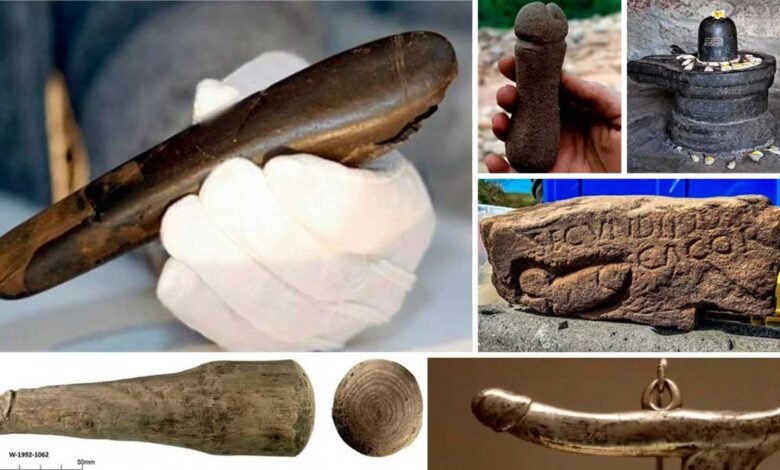
The intriguing realm of human history is adorned with artifacts that range from the mundane to the extraordinary, each resonating with its unique cultural significance. Among these artifacts, phallic symbols stand out as intriguing and enigmatic representations that transcend mere anatomy. Beyond the surface-level humor, these objects reveal deeper meanings, cultural contexts, and even practical applications. Join us on a journey through time as we explore eight renowned phallic artifacts and the profound messages they convey.
1. Hohle Fels Phallus – An Ancient Enigma
Dating back approximately 28,000 years, the Hohle Fels phallus emerges as one of the earliest depictions of male sexuality. Crafted from mammoth tusk, its intricate carvings have spurred debates about its purpose. While some view it as a fertility symbol, others speculate that it served as a multi-faceted tool. It potentially embodied fertility rituals, acted as an early form of a sex aid, and even participated in the practical process of knapping flints. This ancient artifact reveals the interplay between symbolic representation and utilitarian function in prehistoric societies.

Hohler Fels Phallus, aged about 27-30000 years. Discovered in 2004 in cave “Hohler Fels” in the Ach Valley near Schelklingen, Germany. (Hannes Wiedmann, CC BY-SA 4.0 )
2. Shiva Lingam – A Cosmic Union
In Hindu mythology, the Shiva Lingam transcends its phallic form to symbolize Lord Shiva’s divine creative energy and the union of masculine and feminine forces. Representing both creation and destruction, this iconic depiction encapsulates the eternal cycle of life. Found in temples dedicated to Lord Shiva, the Shiva Lingam serves as a focal point for worship, reflecting the intertwining of spiritual awakening and fertility.

Shiva lingam. ( saiko3p / AdobeStock)
3. Cerne Abbas Giant – A Monumental Mystery
Carved into an English hillside, the Cerne Abbas Giant showcases a colossal male figure with a prominent phallus. Though its origin remains shrouded in mystery, theories propose it as a fertility symbol or a territorial marker. Its enduring symbolism of male potency resonates across time, inviting speculation about its role in ancient rituals and beliefs.

Aerial shot of the Cerne Abbas Giant. (Dorset Council / CC BY-NC-SA 2.0 )
4. Vindolanda Phallus – Ancient Eros Unveiled
Unearthed near a Roman fort along Hadrian’s Wall, the Vindolanda Phallus challenges assumptions about its purpose. Initially labeled as a darning object or charm, a closer look reveals signs of wear suggesting a different use. This life-sized artifact, worn smooth with “use,” invites speculation about its role as a sex aid or even a tool of dominance.

The Vindolanda Phallus discovered near Hadrian’s Wall, was it a Roman dildo or torture device? ( Antiquity/NewCastle University )
5. Roman Penis Graffiti – A Playful Inscription
Throughout history, human nature has expressed itself through humor, even in unexpected places like Roman graffiti. Scattered along Hadrian’s Wall, these phallic inscriptions evoke amusement and shed light on the playful side of ancient Roman soldiers.

This phallus has insulting Roman graffiti above it that was meant for another Roman soldier. The insult reads: “You shi**r!” ( Vindolanda Charitable Trust )
6. Turin Erotic Papyrus – An Ancient Guide
The Turin Erotic Papyrus ventures into the realm of ancient sexual practices. This Egyptian document, adorned with explicit illustrations, serves as a testament to the openness and acceptance of sexuality in ancient Egyptian culture. As a historical guide to sexual rituals, it offers insights into intimate aspects of daily life.

The Turin Erotic Papyrus, famous due to its erotic content. An ancient Egyptian papyrus scroll-painting dating back to about 1150 BC, it was discovered at Deir el-Medina in the 19th century and was found to include various erotic vignettes which show sex positions ( Public Domain )
7. Torre de Meira Medieval Stone Penis – A Surprising Weapon
From medieval Spain emerges an unexpected artifact – a stone penis believed to have served as a whetstone for swords during peasant uprisings. With a distinctive history tied to conflict, this artifact challenges assumptions about the purposes of phallic symbols.

Archaeologists uncovered a medieval stone phallus they believe may have been used to sharpen weapons. ( Árbore Arqueoloxía S.Coop.Galega )
8. Ancient Egyptian Amulets of the God Min – Fertility and Beyond
Amulets shaped like the phallus have adorned cultures throughout history, including ancient Egypt. Depicting the god Min, these amulets encompass fertility, protection, and spiritual power. They offer a glimpse into ancient beliefs surrounding sexuality and the divine.

The penis pendants, were worn by children to ward off illness. (David Perez / CC BY 4.0 )
A Deeper Perspective
These eight phallic artifacts, spanning millennia and cultures, transcend their form to convey profound messages. Beyond the surface humor, they reveal human fascination with creation, fertility, protection, and the divine. In a world where anatomy intertwines with symbolism, these artifacts remind us of the intricate tapestry woven by our ancestors – a tapestry that continues to shape our understanding of the past and the present.
Top image: Famous phalluses in history. Source: Hannes Wiedmann, CC BY-SA 4.0 , saiko3p / AdobeStock, Dorset Council / CC BY-NC-SA 2.0 , Vindolanda Charitable Trust , Árbore Arqueoloxía S.Coop.Galega , David Perez / CC BY 4.0





Your article helped me a lot, is there any more related content? Thanks!